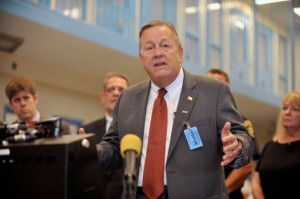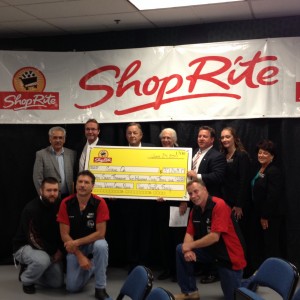Over $83 Million Will Build or Preserve 1,328 Units of Housing, Create Over 2,000 Construction Jobs
SPRINGFIELD – Monday, July 7, 2014 – Governor Deval Patrick today announced $83.6 million in funding to create 24 affordable housing projects across the state, building on the Patrick Administration’s commitment to improving housing infrastructure to support growth and opportunity throughout the Commonwealth. In all, the projects will create 1,328 units of housing and over 2,000 jobs.
“Affordable housing helps to generate jobs, grow local businesses and strengthen our communities” said Governor Patrick. “Government’s role is to help people help themselves, and sustainable affordable housing will create growth and opportunity in our communities that will last for generations to come.”
Since 2007, the Patrick Administration has invested over $1 billion in state and federal resources to create 24,000 units of housing, of which approximately 22,000 are affordable.
Last week, Governor Patrick released his Fiscal Year 2015 Capital Investment Plan, which builds upon the Administration’s successful efforts to stimulate job creation and support long-term economic growth by making record level investments in higher education, innovation and infrastructure projects. The FY15 Capital Plan continues to make investments in low-income housing development, including increased levels of funding for programs that support the production and preservation of affordable housing for low-income families and individuals, as well as community-based housing for clients of the Department of Mental Health and Department of Developmental Services.
“Providing quality housing to those who need it must be a priority,” said Congressman Mike Capuano. “I commend the Patrick Administration for its commitment to creating housing for families most in need.”
“Even as our economy continues to improve, more and more families are having difficulty finding safe, affordable housing,” said Congressman Jim McGovern. “I’m particularly pleased to see the investments in Northampton and Greenfield announced today. I commend the Patrick Administration for their continued commitment to this important issue.”
“These funds will help provide affordable and secure housing to families in Fitchburg, Haverhill, and Lunenburg, with economic ripple effects across the Third District,” said Congresswoman Niki Tsongas. “Projects such as these prioritize the reuse of historic buildings, boost the local economy and help put people back to work, making them a valuable investment in our communities.”
In November 2012, Governor Patrick announced the Commonwealth’s goal of creating 10,000 multi-family housing units per year. By creating this type of housing, which is attractive to young families and individuals, Massachusetts is better prepared to keep in state the skilled, young workforce which employers are seeking.
Last fall, Housing and Economic Development Secretary Greg Bialecki accepted a national “workforce housing” award from the Urban Land Institute, recognizing the Patrick Administration’s leadership in pursuing a strategy to increase the supply of housing needed, and in the places needed, for its workforce.
Improving the housing stock at all levels is a priority for the Patrick Administration. Along with creating new housing, the Administration has made significant investments in the Commonwealth’s public housing stock, by preserving and improving the 46,000 housing units in the system through increased capital funding, increased operating subsidies and changes in management of those resources.
“Housing is the cornerstone to economic success in the Commonwealth,” said Undersecretary of the Department of Housing and Community Development (DHCD) Aaron Gornstein. “Through key initiatives and collaborations across state government and with our local partners, we continue to ensure a stable and robust housing market for our neighbors and our communities. Expanding and preserving affordable housing opportunities for families and seniors with modest incomes is especially important.”
“This investment in affordable housing is critical for families living in the high-cost, Metro-Boston area,” said State Senator Sal DiDomenico. “These developments are vital to keeping Massachusetts’s competitive edge in our current economy, keeping valuable workers from moving out of state, and will give average residents the ability to live, work, and send their children to schools in the cities and communities that they call home.”
“These investments will make sure high quality affordable housing is within the reach of working families,” said State Senator Benjamin B. Downing. “I applaud the Patrick administration for maintaining their commitment to investing in communities across Massachusetts.”
“I am thrilled by Governor Patrick’s announcement today about continued investments in affordable housing,” said State Senator James T. Welch. “Preserving and creating affordable housing is essential to the success and stability of families here in Western Massachusetts and throughout the Commonwealth.”
“The Fitchburg Yarn Mill is a historic complex of buildings on the Nashua River,” said Representative Stephen L. DiNatale. “This revitalization project is a beautiful example of an effective public-private partnership and a successful redevelopment project.”
“This will be a great help in restoring a significant number of housing units in one of the City’s oldest, and more substantial, complexes,” said Pittsfield Mayor Dan Bianchi.
“The City of Greenfield, a “green” community, has been a staunch supporter of Governor Patrick’s call to rebuild affordable housing for all levels of the wage scale,” said Greenfield Mayor William Martin. “As an active participant evidenced by new and substantial rehabilitation of the 55-year-old Oak Courts Veterans family housing of 72 units and single family home developments in several locations, Greenfield will provide additional modern and energy efficient housing at Leyden Woods for working families. This housing, coupled with the availability of new jobs in surrounding industries, will continue the momentum toward our economic development goals. I thank the Governor and Secretary Bialecki for recognizing Greenfield as a partner on their team.”
“This funding for Highland Woods is crucial to Williamstown’s goals of increasing affordable housing and relocating residents of The Spruces mobile home park decimated by Tropical Storm Irene,” said Williamstown Town Manager Peter L. Fohlin. “Governor Patrick and Secretary Bialecki have been steadfast supporters of our recovery efforts to provide homes for as many Spruces families as possible, as well as other deserving seniors. “This project is only possible thanks to the committed partnership of private developers, town funding, and State financial and technical support.”
The following projects were announced today:
75 Amory Avenue, Boston, is a new construction project located in the Jamaica Plain neighborhood and sponsored by Jamaica Plain Neighborhood Development Corporation (JPNDC). DHCD will support the project with federal Low Income Housing Tax Credits, federal HOME funds and state bond subsidies; the City of Boston also will support the project. When completed, 75 Amory Avenue will offer 39 affordable units for families, with eight units reserved for households earning less than 30 percent of area median income.
RTH Riverway, Boston, is a new construction project located in the Longwood Medical Area and sponsored by Roxbury Tenants of Harvard (RTH). DHCD will support RTH Riverway with federal and state Low Income Housing Tax Credits, federal HOME funds and state bond subsidies; the City of Boston also will provide funds to the project. When completed, the project will include 60 affordable units for families, with 14 units reserved for households earning less than 30 percent of area median income.
Whittier-Lyndhurst-Washington, Boston, is a part preservation, part historic re-use and part new construction project located in the Dorchester neighborhood and sponsored by Codman Square Neighborhood Development Corporation. DHCD will support the project with federal Low Income Housing Tax Credits, federal HOME funds, and state bond subsidies; the City of Boston also will support the project. When completed, Whittier-Lyndhurst-Washington will offer 44 affordable units for families, with 13 units reserved for households earning less than 30 percent of area median income.
Port Landing, Cambridge, is a new construction project located in Kendall Square sponsored by Capstone Communities and Hope Real Estate. DHCD will support the project with Housing Stabilization Funds, Commercial Area Transit Node Program Funds, Affordable Housing Trust Funds; the City of Cambridge will also support the project. When completed, the project will include 20 affordable units for families, with two reserved for households earning less than 30 percent of area median income.
Chapin School Veterans Housing, Chicopee, is the adaptive re-use of a historic school building. The project is jointly sponsored by Soldier On, Inc. and the O’Connell Development Group, Inc. DHCD will support the project with federal Low Income Housing Tax Credits. It will also be supported by funding from the City of Chicopee. When completed, Chapin School will offer 43 units of housing for veterans, all of which will be affordable. Nine of the 43 units will be reserved for households earning less than 30 percent of area median income.
Village at Lincoln Park, Dartmouth, is a new construction family housing project to be built on the site of a former amusement park. It is the first of several phases to be built on the site which received a 40R designation. Other planned phases include an elderly rental project, as well as single family homes. The Town is very supportive and has contributed $100,000 from the Dartmouth Affordable Housing Trust Fund to this phase of the project. This phase will consist of 36 family units, of which four will be reserved for households earning less than 30 percent of area median income.
Island Creek Village North Age Restricted, Duxbury, is a new construction project sponsored by Beacon Communities. DHCD will support the project with federal and state Low Income Housing Tax Credits and Affordable Housing Trust Funds. When completed, Island Creek Village North Age Restricted will offer 94 units of affordable housing for residents aged 55 and older. The sponsor is reserving 19 of the 94 units for households earning less than 30 percent of the area median income.
Fitchburg Yarn Mill Phase III, Fitchburg, is the adaptive re-use of a historic mill building sponsored by Winn Development. DHCD will support the project with federal and state Low Income Housing Tax Credits, federal HOME, Housing Stabilization Fund, Community Based Housing, Facilities Consolidation Fund and Affordable Housing Trust Fund subsidies. When completed, Fitchburg Yarn Mill will offer 38 units of affordable housing for families. The sponsor is reserving 10 of the 94 total units for households earning less than 30 percent of the area median income.
Leyden Woods Apartments, Phase I, Greenfield, is a new construction and preservation project sponsored by The Community Builders. DHCD will support the project with federal Low Income Housing Tax Credits, state Low Income Housing Tax Credits, Capital Improvement and Preservation Fund, Community Based Housing, Facilities Consolidation Fund and Affordable Housing Trust Fund subsidies. When completed, Leyden Woods Apartments Phase I will offer 113 units of affordable housing for families. The sponsor is reserving 23 of the 113 units for households earning less than 30 percent of the area median income.
Tenney Place Apartments Phase I, Haverhill, is a new construction project sponsored by Dakota Partners. DHCD will support Tenney Place Apartments with federal and state Low Income Housing Tax Credits, federal HOME funds and state bond subsidies; the City of Haverhill also will support the project. When completed, Tenney Place Apartments will offer 72 affordable units for families; 56 units will be affordable, with eight units reserved for households earning less than 30 percent of area median income.
Tritown Landing Phase III, Lunenberg, is a new construction project sponsored by Great Bridge Properties. DHCD will support the project with federal Low Income Housing Tax Credits, federal HOME, Housing Stabilization Funds and Affordable Housing Trust Fund subsidies. When completed, Tritown Landing Phase III will offer 32 units of affordable housing for families. The sponsor is reserving four of the 32 units for households earning less than 30 percent of the area median income.
Shoe Shop Place, Middleborough, is the adaptive re-use of a historic mill building. The project is jointly sponsored by The Neighborhood Corporation and Neighborhood of Affordable Housing, Inc. DHCD will support the project with federal Low Income Housing Tax Credits and Affordable Housing Trust Fund subsidies. It will also be supported by funding from the Town of Middleborough and the Greater Attleboro and Taunton HOME Consortium. When completed, Shoe Shop Place will offer 24 units of housing for families, all of which will be affordable. Five of the 24 units will be reserved for households earning less than 30 percent of area median income.
Christopher Heights, Northampton, is a new construction project sponsored by The Grantham Group. DHCD will support the project with federal Low Income Housing Tax Credits and Affordable Housing Trust Fund subsidies. It will also be supported by funding from the City of Northampton. When completed, Christopher Heights will offer 83 units of Assisted Living housing for seniors, 43 of which will be affordable. Seventeen of the 43 affordable units will be reserved for households earning less than 30 percent of area median income.
Leeds Transitional Housing, Northampton, is a new construction project sponsored by Soldier On, Inc. DHCD will support the project with Housing Innovation Funds and Affordable Housing Trust Funds. When completed, the project will include 16 units for women veterans and their children, with four units reserved for households earning less than 30 percent of area median income.
Dalton Apartments, Pittsfield, is a preservation project and sponsored by the Berkshire Housing Development Corporation and Rees-Larkin Development. DHCD will support the project with federal and state Low Income Housing Tax Credits and state bond subsidies; the City of Pittsfield also will support the project. When completed, Dalton Apartments will offer 100 affordable units for families, with 10 units reserved for families earning less than 30 percent of area median income.
Stable Path Rental Housing, Provincetown, is a new construction project sponsored by the Community Housing Resource, Inc. DHCD will support the project with federal Low Income Housing Tax Credits, federal HOME, and state Housing Stabilization and Affordable Housing Trust Fund subsidies. It will also be supported by funding from the Town of Provincetown and the Barnstable County HOME Consortium. When completed, Stable Path will offer 23 units of housing for families, 18 of which will be affordable. Five of the 23 units are reserved for households earning less than 30 percent of area median income.
Kendrigan Place, Quincy, is a preservation project located in Quincy and sponsored by NeighborWorks of Southern Massachusetts. DHCD will support the project with Low Income Housing Tax Credits, state Low Income Housing Tax Credits, federal HOME, Community Based Housing, Capital Improvement and Preservation Fund and Affordable Housing Trust Fund subsidies. It will also be supported by Quincy HOME, the Community Preservation Coalition and City of Quincy Affordable Housing Trust funding. When completed, 78 units of affordable housing will be preserved. Eight of the units will be reserved for households earning less than 30 percent of area median income.
189 Broadway, Revere, is a new construction project for seniors sponsored by The Neighborhood Developers. DHCD will support the project with federal Low Income Housing Tax Credits, Facilities Consolidation Fund and federal HOME funds. The development will also receive funding from the North Suburban HOME Consortium. When completed, 189 Broadway will offer 39 units of affordable housing for adults aged 55 and older. The sponsor is reserving four of the 39 units for households earning less than 30 percent of area median income.
Kenwyn Quadrangle, Springfield, is the preservation of two historic buildings that currently house low and moderate-income families. Each property has been owned and managed by HAPHousing for over 15 years. Kenwyn Apartments completed its 15-year Low Income Housing Tax Credit compliance (LIHTC) period in 2010; Quadrangle Court completed its 15-year LIHTC compliance period in 2013. The buildings need recapitalization and additional historic, life and safety improvements. Together they comprise 60 units of housing, of which six will be set aside for households earning less than 30 percent of area median income.
Outing Park II, Springfield, is a preservation and new construction project located in the Outing Park Historic District and is sponsored by the First Resource Development Company. DHCD will support the project with federal and state Low Income Housing Tax Credits, federal HOME funds and state bond subsidies; the City of Springfield also will support the project. When completed, Outing Park II will offer 118 affordable units for families, with 12 units reserved for families earning less than 30 percent of area median income.
Cranberry Manor & Carpenter’s Glen, Wareham and Taunton, is the restructuring of two projects that will bring needed capital improvement and continued affordability to these two affordable housing resources on the South Shore. The project is sponsored by the South Shore Housing Development Corporation, which is the current owner of the project. DHCD will support the project with Affordable Housing Trust Fund, Housing Stabilization Fund and Community Based Housing funds. Six of the units will be reserved for families earning less than 30 percent of area median income.
Highland Woods, Williamstown, is a new construction project sponsored by Berkshire Housing, Inc. DHCD will support the project with federal Low Income Housing Tax Credits, Housing Stabilization Fund and Affordable Housing Trust Fund subsidies. It will also be supported by funding from the Town of Williamstown. When completed, Highland Woods will offer 40 units of housing for seniors, all of which will be affordable. Eight of the 40 units will be reserved for households earning less than 30 percent of area median income.
John Howland Jr. House, New Bedford, is the adaptive re-use of a historic building in New Bedford. The project is sponsored by the Waterfront Historic Area League. DHCD will support the project with federal HOME funds. It will also be supported by funding from the City of New Bedford. When completed, Howland House will offer seven units of housing, five of which will be affordable.
181 Washington Street, Somerville, is a new construction project located in Union Square, Somerville and sponsored by the Somerville Community Corporation. DHCD will support the project with federal and state Low Income Housing Tax Credits, AHTF, CBH and HSF. The development will also receive funding from the City of Somerville. When completed, 181 Washington will offer 35 units of affordable family housing. The sponsor is reserving eight units of the 35 units for households earning less than 30 percent of area median income.
###
http://www.mass.gov/governor/pressoffice/pressreleases/2014/0707-governor-announces-affordable-housing-investment.html










